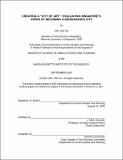Creating a "city of art" : evaluating Singapore's vision of becoming a renaissance city
Author(s)
Lee, Wai Kin, 1975-
DownloadFull printable version (1.402Mb)
Other Contributors
Massachusetts Institute of Technology. Dept. of Urban Studies and Planning.
Advisor
J. Mark Schuster.
Terms of use
Metadata
Show full item recordAbstract
The arts have been used by many cities as a way to regenerate their urban environments and rejuvenate their economies. In this thesis, I examine an approach in which city-wide efforts are undertaken to create a "city of art". Such attempts endeavor to infuse the entire city, not just specific districts, with arts and cultural activities and to develop a strong artistic inclination among its residents. Singapore"s recent plan to transform itself into a "Renaissance City" is an example of such an attempt to create a "city of art". I conceptualize urban cultural policies used to create "cities of art" as having two possible policy orientations. An externally-oriented policy is used to project a city"s cultural achievements into the international arena, often with the intention of generating economic growth and enhancing the city's image. An internally-oriented policy, on the other hand, is focused on cultivating cultural growth within the city and is more directed at achieving local socio-cultural advancement. While some cities may adopt urban cultural policies that are either strongly externally- or internally-oriented, other cities may have urban cultural policies that endeavor to balance both orientations. For Singapore, I will show that the urban cultural policy adopted to transform itself into a "Renaissance City" tries to be simultaneously externally- and internally-oriented. Despite the attempt to address both policy orientations, I argue that the Singapore government has inappropriately placed undue emphasis on external at the cost of internal strategies for arts and cultural development. To evaluate Singapore's vision of becoming a "Renaissance City", I will compare its recently proposed strategies under the two policy orientations to those of two other cities, Glasgow and Chicago, which have implemented their urban cultural policies since the 1980s. While Glasgow"s urban cultural policy is strongly externally-oriented, Chicago's policy is more internally-oriented. Through this comparative analysis, I propose recommendations that will help to enhance Singapore"s strategies to develop a "Renaissance City".
Description
Thesis (S.M.)--Massachusetts Institute of Technology, Dept. of Urban Studies and Planning, 2003. Includes bibliographical references (p. 173-180). This electronic version was submitted by the student author. The certified thesis is available in the Institute Archives and Special Collections.
Date issued
2003Department
Massachusetts Institute of Technology. Department of Urban Studies and PlanningPublisher
Massachusetts Institute of Technology
Keywords
Urban Studies and Planning.